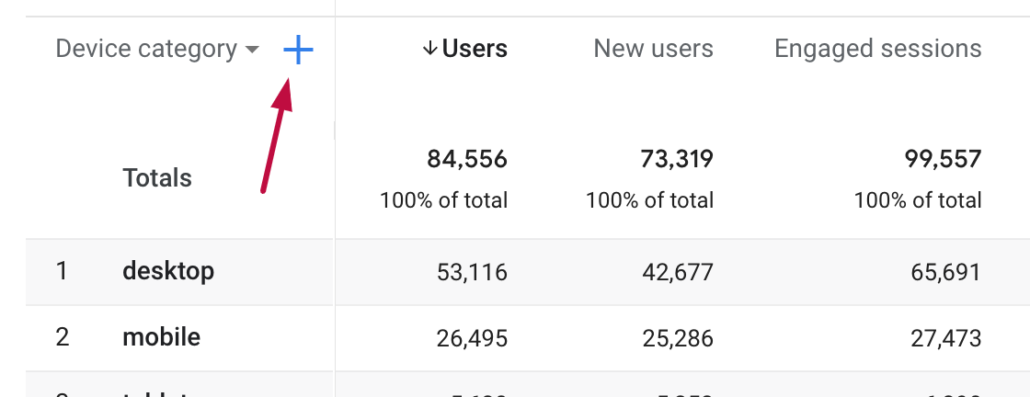Grasping Secondary Dimension in Google Analytics: A Full Guide
Grasping Secondary Dimension in Google Analytics: A Full Guide
Blog Article
Transform Your Analytics Strategy With Additional Measurement in Google Analytics
By integrating second dimensions right into data analysis, a brand-new layer of insights emerges, dropping light on detailed individual behaviors and communications. The critical application of additional dimensions holds the key to opening a treasure trove of important information that can reinvent exactly how organizations translate and act upon their data.
Comprehending Secondary Dimensions in Google Analytics
Second measurements in Google Analytics offer additional context to key information by enabling users to assess metrics across a 2nd dimension, supplying deeper understandings right into customer behavior and communications on a site. Secondary Dimension in Google Analytics. While key measurements offer essential information points such as pageviews, bounce price, and session period, secondary measurements supply a more in-depth view by segmenting the main information even more. This division enables customers to analyze metrics in mix with an additional dimension, such as web traffic resources, demographics, or user habits
Advantages of Utilizing Second Measurements
Utilizing additional measurements in Google Analytics supplies a tactical benefit by improving the deepness of evaluation and giving a much more comprehensive understanding of user interactions and habits on a web site. By integrating second measurements, experts can obtain valuable insights into the performance of particular segments or variables within their data. This enables a much more in-depth assessment of individual habits beyond surface-level metrics, enabling for a deeper exploration of the factors affecting customer interaction and conversions.

Just How to Execute Second Dimensions
When including secondary measurements in Google Analytics, one vital action is to select the appropriate metrics and dimensions to improve the analysis process. To execute second measurements successfully, start by accessing your Google Analytics account and browsing to the record you want to boost with additional data. As soon as in the report, locate the "Second Dimension" button, generally found above the information table. Clicking on this button will open up a drop-down menu listing different measurements that can be contributed to your primary dimension for deeper understandings.
After choosing the proper additional measurement, such as 'Source/Medium' or 'Device Category,' Google Analytics will show the information in an extra detailed style, enabling you to cross-analyze various facets of customer actions. Remember to experiment with different combinations of second and primary dimensions to uncover valuable patterns and trends that can educate your marketing techniques. By executing additional dimensions attentively, you can gain a more detailed understanding of your internet site or application efficiency and make data-driven choices to enhance your digital presence.
Analyzing Information With Additional Dimensions
Improve your data analysis in Google Analytics by including additional dimensions to delve much deeper into customer behavior patterns and optimize your digital advertising techniques effectively - Secondary Dimension in Google Analytics. By including additional dimensions to your primary information, you can acquire beneficial insights that can aid you make informed choices about your web site or application performance
Analyzing information with secondary measurements allows you visite site to section your key data better, offering a much more comprehensive sight of customer communications. Combining the main measurement of 'source/medium' with a secondary measurement like 'touchdown page' can expose which specific web pages are driving traffic from various sources. This info can be crucial in fine-tuning your web content technique or maximizing your ad campaign to raise conversions.
Additionally, making use of additional measurements enables you to recognize relationships between various metrics, aiding you understand the effect of numerous factors on user actions. Whether it's evaluating demographics along with customer interaction metrics or gadget groups with conversion prices, secondary blog here dimensions empower you to discover concealed patterns and patterns that can direct your advertising and marketing efforts.
Maximizing Performance With Additional Dimensions
To boost the effectiveness of information analysis and decision-making in Google Analytics, integrating additional dimensions is essential to enhancing performance metrics and acquiring deeper insights into user behavior patterns. By utilizing secondary dimensions, analysts can delve past surface-level data and uncover beneficial relationships that might otherwise go unnoticed. This optimization approach allows businesses to customize their advertising initiatives better, determine areas for improvement in website functionality, and enhance general customer experience.
Additional dimensions supply an even more detailed view of user communications by offering extra context to primary information metrics. Combining the primary measurement of 'touchdown page' with an additional measurement like 'device category' can reveal whether specific gadgets are more likely to drive engagement on specific touchdown pages. This understanding can inform receptive design enhancements or targeted marketing techniques to enhance performance.

Verdict
In final thought, the assimilation of additional measurements in Google Analytics provides organizations with an effective device to improve their analytics technique. Secondary Dimension in Google Analytics. By delving deeper right into user actions and interactions, marketing experts can discover valuable understandings that can drive performance optimization and enhance the overall individual experience. Leveraging secondary measurements enables for a more detailed analysis of information, look what i found leading to even more enlightened decision-making and tailored advertising and marketing efforts
Second dimensions in Google Analytics supply additional context to main data by enabling customers to evaluate metrics throughout a second dimension, supplying deeper understandings right into user habits and interactions on a web site. While key dimensions give essential information factors such as pageviews, bounce rate, and session duration, additional measurements provide an even more detailed view by segmenting the main information better.One of the crucial benefits of making use of additional dimensions is the capacity to reveal connections and patterns that might not be promptly apparent when evaluating data with key dimensions alone.When integrating additional measurements in Google Analytics, one essential step is to choose the appropriate metrics and measurements to improve the evaluation procedure. Coupling the primary dimension of 'landing web page' with an additional measurement like 'gadget group' can disclose whether particular tools are more likely to drive engagement on specific landing pages.
Report this page